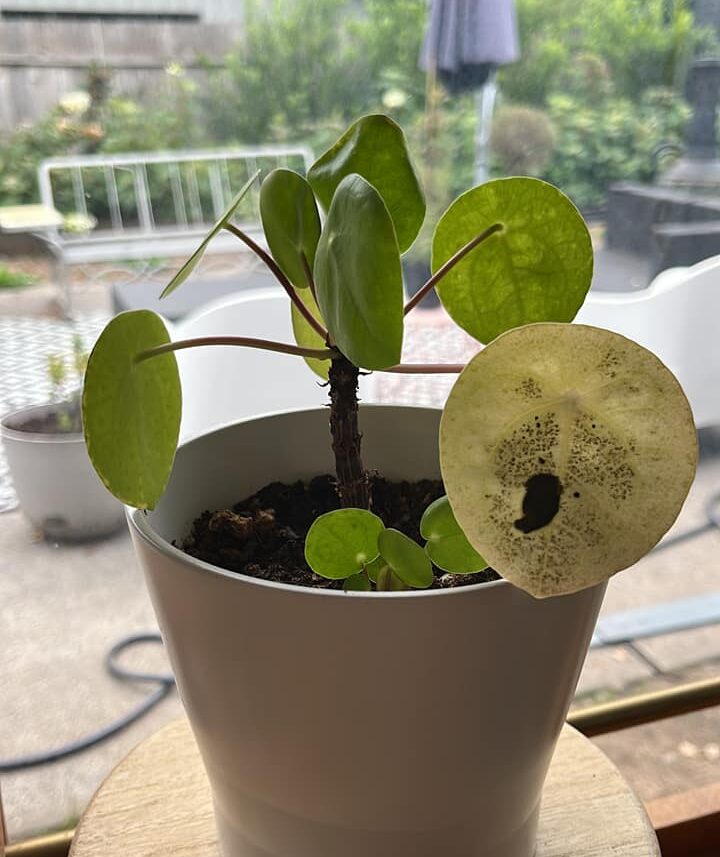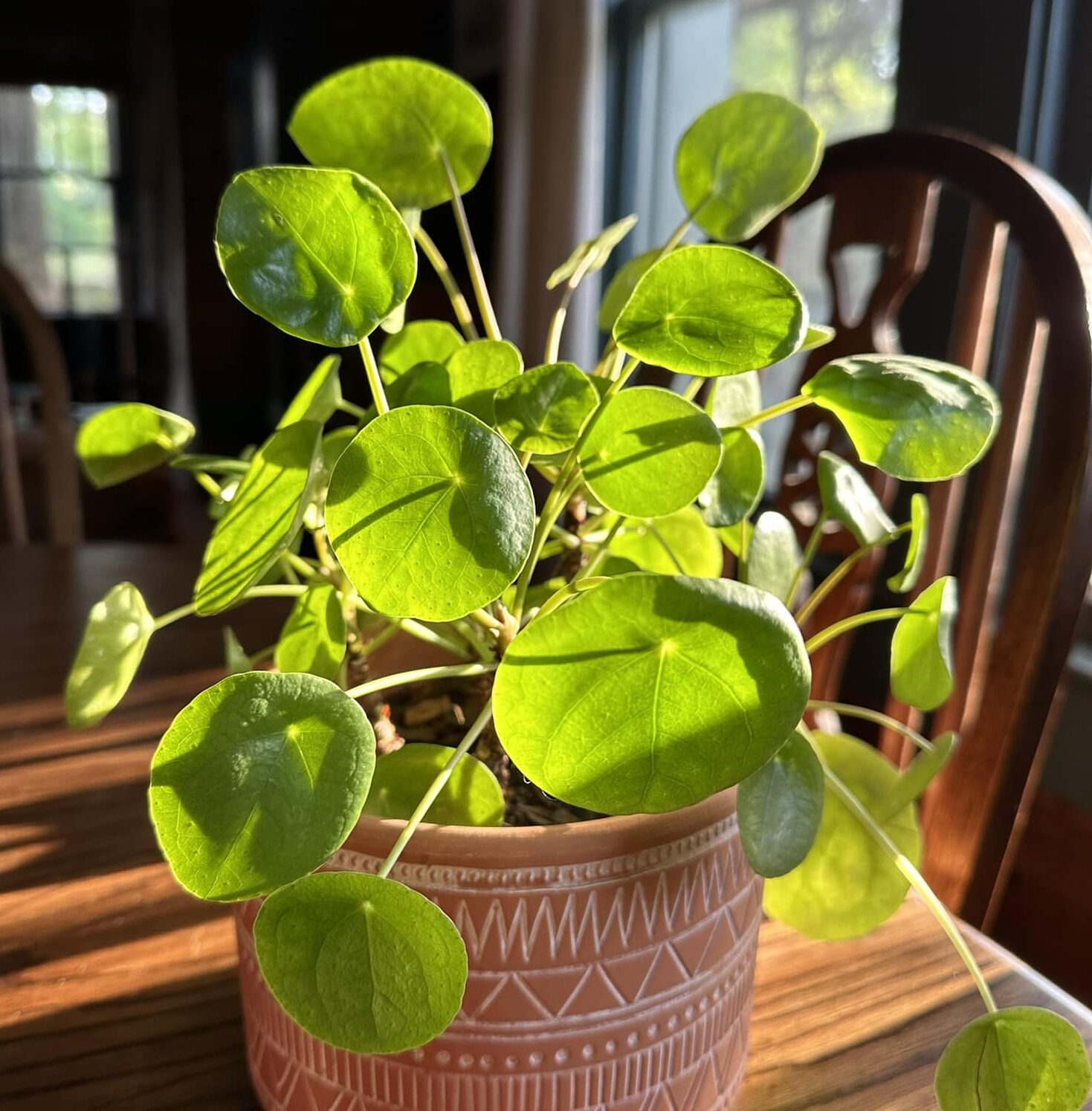Do you know the reasons for your Pilea leaves curling? The common reason is watering issues, but many underlying culprits exist!
So, if you are searching for solutions to make your Pilea back to normal, go through this article till the end.
Table of Contents Show
What Does It Mean When Pilea Leaves Curl?
Leaves in Pilea curl up when new or if the leaves belong to a juvenile Pilea seedling.
Pilea leaves curling downwards are an upshot of excessive light, low water, high temperature, and low nutrients. But Pilea leaves curling upwards signifies the effect of overwatering or low light.

However, it’s entirely normal for old Pilea plants to curl their leaves when they are about to drop them off the plant to reduce unwanted energy allocation.
Hence, let the natural process continue if the leaves curl due to aging, but if they are curling due to transplant shock, wait until the plant heals on its own.
Why Are My Pilea Leaves Curling?
Here are some of the reasons behind your Pilea leaves curing.
1. Excessive Watering
Overwatering makes your Pilea suffer from root rot, which causes the plant leaves to curl.
Usually, Pilea leaves curl upwards to form a cup called “cupping” due to overwatering. Roots rot, causing a disconnection between the upper plant parts and the roots.
Hence, the plants cannot uptake water, causing discolored, droopy, and yellow leaves.
However, sometimes your plant may face mixed cupping, which may signify various problems.
How To Fix?
- Use a terracotta pot with drainage holes for proper seepage of water.
Remember!
Water your Pilea when the top inch of the soil is dry. Overwatering cause the roots to suffocate below the soil and cannot absorb oxygen.

- Follow the appropriate watering habits to prevent your plants from root rot.
- Don’t totally deprive your plant of water, or it may develop signs like brown tips and droopy leaves.
- Move your Pilea pot under direct sunlight to dry up the soil.
- Remove any obstructions from the drainage holes.
- Amend the potting mix with organic perlite and lay some pebbles at the pot’s base to encourage drainage.
- Water every week during spring and summer. But, water every 2 weeks during winter.

2. Inadequate Sunlight
Pilea originates from New World, Tropical & Subtropical Old World. Thus it prefers indirect sunlight and warm temperature.
Pilea leaves curl downwards due to water loss caused by excessive temperature and light. The leaves roll to save the remaining water.

Additionally, your plant may face problems like yellowing, drooping, leaf tip burns, and foliar searing due to excessive sunlight.
However, in low-light situations, the leaves expose as much surface area as possible to enhance photosynthesis.
Hence, the leaves extend towards the light source, giving the plant a leggy and droopy appearance.
Remember!
Pilea leaves curling downwards is an outturn of low light, as the plant without light cannot photosynthesize, prepare food, and transpire.
To preserve the remaining energy, the leaves curl and reduce water loss.
How To Fix?
- Keep your Pilea about 3-6 inches from an east-facing window, or use drapes to protect them from direct sunshine.
- For even light distribution, rotate the plant in quarter turns each week and use grow lights during low light.
- Cut out the leggy leaves to clear the bushy overgrowth for comfortable light incidence within the plant.

3. Temperature Stress
As a tropical plant, Pilea prefers a warmer temperature for proper functioning.
Generally, Pilea prefers a temperature of around 55-75°F, but if it exceeds 80°F, the leaves may curl due to temperature stress.
Surplus temperature makes the cellular water in the plants evaporate more quickly than it would normally.
Hence, it’s usual to observe your Pilea leaves curling downwards due to high temperature as the plant tries to save water.
Do You Know?
In freezing temperatures (below 50°F), the plant loses a lot of water due to cold and dry air resulting in the upward curling of leaves!

How To Fix?
- Keep your plant out from north-facing windows or cooling or heating vents during winter.
- Provide a frost blanket or heating pads to reduce frost injury to roots and shoots.
- Place the plant inside a greenhouse to warm up the ambient temperature.
4. Low Humidity
Pilea is native to the humid conditions of rainforests and loves sultry surroundings.
Generally, Pilea grows optimally in humidity from 50-75%. Below this, the leaves will curl to save moisture.
Low moisture can lead to brown leaf edges, yellow leaves, and dehydration.
Moreover, Pilea leaves curl back down with low surrounding humidity.
How To Fix?
- Employ a pebble tray to adjust the humidity levels.
- Furthermore, mist your plant every 2 weeks in the morning.
- Try grouping your plant with other houseplants in bathrooms.
5. Lack of Nutrients
Pilea is known for being a low-maintenance plant that doesn’t require frequent fertilization.
But a nutrient-deficient Pilea will curl down its bottom leaves, and you must fulfill its nutrient demands by adding fertilizers.
Pro Tip!
During fall and winter, halt the fertilizer application until spring to reduce the chance of overfertilization and fertilizer burns.
To treat curled leaves, offer a monthly dose of half-strength balanced liquid 20-20-20 fertilizer every month during spring and summer.
Solution and Preventive Measures
- Feed your plant amino-acid supplements to fulfill nitrogen demands.
- Maintain the soil pH between 5 and 6. Alkaline soil may slow down nutrient uptake resulting in leaf curl.
- Always water the plants before applying fertilizer so the nutrients reach deeper layers into the soil.
6. Root Rot
Root rot causes Pilea leaves to curl due to the damage to the root system resulting from pathogenic attacks.
All root rots are caused by fungal pathogens attracted to soggy and moist soil conditions.
Due to fungal attacks, the roots turn mushy and brown. The roots cannot absorb minerals and moisture, so the leaves curl to recover water.

Excessive watering can cause root infections and dysfunction, forcing leaves to curl for moisture protection.
Besides root rot, leaves may also curl due to root bounding, but repotting solves both problems.
How To Fix?
- By carefully removing it from the pot, check if your plant has root rot or is root-bound.
- Remove the soil, pull the plant from the pot, and untangle the roots.
- Cut away all the infected roots using sterilized pruners and keep healthy white-tan roots intact.
- Then, select a larger pot and fill it one-third with well-draining soil.
- Place the plant in the new pot and fill the soil from the sides.
- Resume regular care to promote healthy growth.
7. Pest Infestations
The Pilea can attract pests, but you can always protect your plant with a diagnosis.
Some pests like Aphids, Spider mites, and Mealybugs feed on plant sap, leading to curling of the leaves.

Let’s look at how to identify these pests.
| Insects | Symptoms |
|---|---|
| Aphids (Pear-shaped, green insects) | Foliage looks crinkled or stunted |
| Spider Mites (Spider-like mites shrouded with webbings) | Lower side of leaves have spidery webs |
| Mealybugs (White, cottony masses) | Plant wilts, discolor and curl |
| Fungus Gnat (Larvae of Gnat flies crawling in the potting soil) | Plants will grow poorly and have foliage loss |
How To Fix?
- If the pests are visible to the naked eye, wear gloves and handpick them.
- You can catch fungus gnats with yellow sticky tapes.
- Apply neem oil to the plant if any insect eggs are visible.
- Use Q-tips dipped in isopropyl alcohol to dab the visible pests.
From Editorial Team
Conclusion!
Sometimes, Pilea may face leaf curl due to lack of air circulation. Ensure that the soil is airy and fluffy to aerate the roots.
Also, remember that curled leaves can’t be revived, so pruning them will be helpful to save energy.


